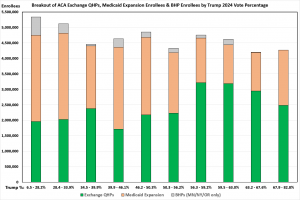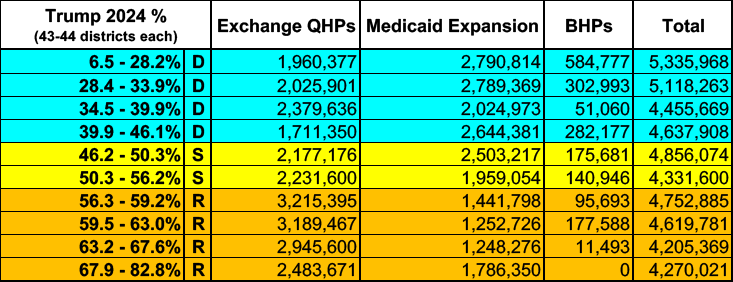Red v. Blue: Who'd be screwed most by the #MedicaidMassacre bill?

With the House Republican budget bill having made it past its second significant hurdle last night (the House Budget Committee vote), it's time tot ake a cold, hard look at just what the impact of the bill will be in pure partisan terms.
The logic Congressional Republicans (or at least Donald Trump, who pretty much has complete control over the Congressional Republican hivemind) seem to be going with is that targeting the Medicaid expansion population is good politics for them because a) it's a lot easier to attack so-called "able-bodied" adults than children, seniors, the disabled & pregnant women; b) they can strip coverage away from millions of Expansion enrollees without ever explicitly declaring them to be ineligible; c) they can blame the enrollees themselves for losing coverage when they fail to clear every administrative hudle the states will be required to force them to jump over; and d) 9 of the 10 states which never expanded Medicaid under the ACA in the first place are red states anyway, meaning gutting the program won't impact most of their base.
As an added bonus, they get to gut a significant portion of the Affordable Care Act in the process.
On the flip side, a lot of Democrats I've been talking to seem to be under the impression that a) most Medicaid enrollees are MAGA (white rural Republicans), and that therefore "Face Eating Leopards" and all that.
So...I decided to break out the numbers to see just where things actually stand on this front.
It's important to keep in mind that the ~20 million Americans enrolled in Medicaid via ACA expansion actually only make up less than half of the ~46 million whose healthcare coverage is at risk from the House GOP budget--there's also around 24.2 million ACA exchange Qualified Health Plan (QHP) enrollees who are facing devastating premium hikes if the IRA subsidies aren't extended beyond the end of December (not to mention some nasty little ACA administrative surprises baked into the budget bill itself), as well as around 1.8 million in Minnesota, New York & Oregon specifically enrolled in Basic Health Plan (BHP) policies.
I should note as an aside that the impact of the IRA subsidies expiring on BHP enrollees is a little trickier to determine; the programs in all three states would likely become less generous, but the nature of the programs makes it a bit harder to predict what changes would have to be made. Plus, New York in particular has an unusually large cash reserve for their BHP program which might keep it cushioned for a few years.
The first thing I did was to add up all three categories by state and then group the states into simple Red, Blue and Swing State status (the 7 states generally accepted as being "swing states" at the moment are Arizona, Georgia, Michigan, Nevada, North Carolina, Pennsylvania and Wisconsin).
Doing so gives me the following:
At the statewide level, there's over 2.5x as many people enrolled in ACA exchange plans in the red states as in the blue states...but there's also 3.1x as many enrolled in Medicaid via ACA expansion in the blue states as the red states. Huh. Overall, there's perhaps 11% more Americans at risk in the blue states than the red ones...not nominal, but not exactly overwhelming either. All 3 states with BHPs are blue, so that's a shut out.
This is an extremely oversimplified way of looking at it, however. There are millions of Republicans living in blue states like California and New York, and millions of Democrats living in red states like Texas and Florida. A statewide view really doesn't tell us much.
So, my next step was to run the numbers at the Congressional District level.
Using my updated CD-level estimates of enrollment in Exchange QHPs, BHPs and Medicaid Expansion, I separated all 436 House districts (don't forget DC!) by Red (Republican) and Blue (Democratic) winners.
Doing so looks like this:
Hmmm...once again, overall, there's around 11% more people enrolled in one of the three programs in districts won by Democrats than in districts won by Republicans. The gap in the first two categories is far less dramatic, however: Only 34% more QHPs in red districts and only 65% more Medicaid expansion enrollees in blue districts. The BHP gap is also less pronounced, since about 22% of BHP enrollees live in red districts within blue states MN/NY/OR.
Of course just as blue states aren't completely blue & red states aren't completely red, the same is true of Congressional Districts.
Therefore, I've gone one step further and broken all 436 districts out by partisan lean, using this extremely handy spreadsheet from The Downballot.
Instead of using the performance of each individual House member--which is sometimes subject to quirks in that individual race which aren't representative of the district itself--I'm going with what percent of the vote Donald Trump received in the November 2024 election.
I then grouped all 436 districts together into tenths, ranging from the deepest blue (Trump only received 6.5% in DC) to the deepest red (he received 82.8% of the vote in Alabama's 4th House district).
Here's what that looks like...
...and here's what it looks like visually:
The skyrocketing ACA exchange premiums will hit more red district residents starting in January 2026...while the Medicaid expansion's Job Loss Penalty (as Data for Progress puts it) wouldn't kick in until a year later, but would hit more blue district residents. It's also important to note that a significant chunk of the blue district portion of coverage under threat is via BHP enrollees, who, as I noted above, might not be impacted as severely as the other two categories.
So, there you have it: No matter how you slice it, assuming the House Republican budget bill is passed, signed & implemented and Congress doesn't extend the IRA subsidies beyond the end of 2025, tens of millions of Americans in BOTH red and blue districts & states are going to be utterly screwed in the near future, and millions of them will lose healthcare coverage completely.







